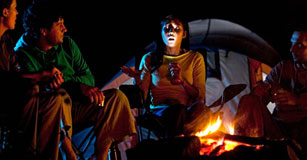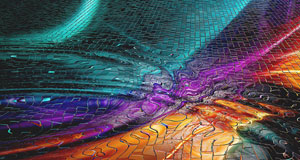The Art of Digital Storytelling
Become a 21st Century StoryKeeper™

“Tell your tales; make them true. If they endure, so will you.”
—James Keller
Gather round those roaring campfires, picnic tables, or even a fondue pot, because the ancient art of storytelling is being revived into an emerging communication mode called digital storytelling. Stories are as old as people and are more important than ever for our spirits, minds, and human progress. Becoming good storytellers gives us personal power as we guide, motivate, entertain, educate, inspire, and influence others through the artful use of story.
Designing and communicating information requires students to deepen their understanding of content while increasing visual, sound, oral language, creativity, and thinking skills. Making meaning out of an experience deepens the communication for both the author and the viewers. The author’s narrative voice is the center of all the multimedia decisions. The story’s narrative is first made into a voiceover and then all images, sound, music, transitions, and special effects are organized around unfolding this story.
Telling stories together about things that really matter has an extraordinary effect on people. Digital media and digital distribution to the world community is reshaping the power of oral storytelling, enabling us to unfold a highly sensory experience that dances a narrative voice with images, sound, and music into illuminated understandings. What an experience to incorporate digital storytelling into your classroom and guide a new generation into becoming 21st- Century StoryKeepers™, knowing their personal narratives will endure for others long after the fires die down!
Take Six: Elements of Good Storytelling
To help increase the quality of student stories, I developed Take Six: Elements of Digital Storytelling. For example, Showing not Telling is a quality long expected in good writing pieces, and this same element also creates exceptionally good stories as well. However, I want to focus on two specific elements in this article because they are considered especially essential for good storytelling: Living in the Story and Unfolding Lessons Learned. If either of these two elements is missing, you likely are viewing a great digital story... but not storytelling.
Living in the Story
So many digital stories are telling about their topics; even personal ones such as a story about grandma, a pet, or getting a first bicycle. Even if told very well, we often can’t feel the author in these about tales. Digital storytelling encourages authors to write a very personal emotional connection with the tale being told. The power of storytelling is not in telling about an event or someone else’s life, but rather in shifting the lens to using the setting, details, and events for telling your story with the experience.
You may not be a character in the story, but your audience should still be able to feel what you feel or how the situation affects you. In A Whole New Mind, Daniel Pink defines story grammar as the “ability to encapsulate, contextualize, and emotionalize information, understanding, and experiences for yourself and others.” Emotionalizing information gives important “sticking power” in our brains and for our audience. The written narrative for storytelling should be coached as a first-person perspective, unfolding the storytelling from the author’s heart, not his or her head.
Unfolding a Lesson Learned
Have you ever been with someone who is telling a story and seems to be going on and on and on? You begin to get restless, wondering… is there a point here you are trying to make? Good storytelling needs a “spine” to hold the audience’s attention and deliver a timely, memorable ending. Good storytelling strives to find the essence of meaning or value this person, experience, or situation made in their lives. The lesson learned is a kind of moral of the story, such as the ones we find in fairy tales—revealing the wisdom or understandings gained from the experience or knowledge. Wrapping up each digital storytelling with a lesson learned also gives it depth and meaning beyond the “what happened” story points.
Finding the Lessons Learned
Frequently an author knows the story he or she wants to tell but has not made meaning out of it yet. What does my sister’s autism mean to my life? How do I find meaning in my life as a foster child? What do I now know, believe, or understand about the world from this experience? It requires the author to dig deep, reflect, and make personal meaning beyond the facts. Finding the lesson learned significantly changes authors as well as the experience they create for their audience.
Good storytelling is a journey for every author who is digging deep into the meaning of their stories for themselves and others. As part of a digital storytelling week, I worked with Ms. Liza Medina’s middle school class at Ramapos Central Schools, New York. Students were given the task of finding their own visual parallel personal stories to unfold while narrating Robert Frost’s poem, “The Road Not Taken”.
When students began, they struggled to create more than a literal connection to the poem. When we tried to get them to uncover their own emotions and feelings behind their experience with Frost’s poem, students clammed up. After numerous efforts, Ms. Medina decided to share her own story two different ways (see below).
Story Transformation
Version 1
When I was in college, I left the education department for six months. One of my education professors refused to take me on school visitations to observe classrooms. She told me I looked too much like the kids and didn’t act my age. Once when I turned in a paper two days late, she refused to grade it. She pulled me aside and told me that I was never going to be able to become an effective teacher because I was too immature. I became angry. She had recommended to the head of the education department that I be removed from the program. Rather than fight with her, I dropped my education major and took up jewelry making and photography. After one semester outside of the education department, I decided to appeal to the head of the education department. With a renewed conviction, I rejoined the education department.

Version 2
Dr. Sawyer looked down her narrow pointy nose at me. “So why do you want to teach?”
Because I taught Michelle how to tell time when I was in second grade. Because I taught Samantha how to speak Spanish last summer. Because I don’t know how not to be a teacher.
None of these answers would be enough for her. Intimidated by her icy stare, I muttered, “I don’t know.”
“Then there is no reason for you to waste your time in this department.” she declared. “You do not have the disposition of a teacher. Your behavior is no better than that of the children.”
Because Hope Ann and I smile in your classroom? Because we giggle and chat with students in the hallways?
Anger boiled in my head. I like children. They’re happy! Why is it a crime for me to be, too? “You look like students, you dress like students, and you act like students. You are not fit to be in the classroom.” She turned away from me with a dismissive tone. Stunned and outraged, I only managed a passive nod.
Defeated and humiliated I wandered in a daze, reluctantly arriving at my advisor’s door. I handed him my second semester registration form with “Fine Arts” scrawled in my shaky handwriting across the top next to the word Major. He signed his approval.
I lived with my misery every day the following semester; making jewelry, taking photographs, and doing art critiques. My spirit was flat and unconnected. I missed the kids. I missed my dream of making a difference, student by student, through the years.
When time came to register for next semester’s classes, I realized that I was wasting my time and ambition. I appealed to the head of the education department and won. With renewed conviction, I rejoined the education department. I knew then that I would never again let someone else dictate my future or take my life dreams away. My dreams are mine to make true, even when others don’t believe in them. I believe, and that is all that matters.
After sharing her first story, Ms. Medina said, “See? I almost wasn’t a teacher at all!” Joshua, sarcastic as usual, shouted out, “Good!” After sharing the second story, she turned back to Joshua asking, “Do you still feel like saying ‘good’ after this one?” “No,” Joshua said, “The first one was just a summary, like the words on the back of a book. It’s telling what happened, but not telling it real. But I feel sad after the second one about how that teacher treated you. You had to kinda face a bully, but you won. You made it very real.”
Then something very interesting happened—Joshua volunteered first to tell his story. Normally, Joshua is a Hockey Player—capital H, capital P, ALL Hockey, ALL the time. Joshua told us very briefly about being six years old and choosing to play hockey for the first time with a traveling team. He talked about getting up at 4 AM, going to practices early in the morning before light and coming home late at night when it was dark. He talked about having no time for family and no time for friends.
In that moment, Joshua became more than just a Hockey Player to us—Joshua became a scared, insecure human being. This is not the boy his classmates are used to—usually wisecracking, quick witted, and sarcastic. This person sounded like he wasn’t so sure that being ALL Hockey, ALL the time was the best choice. This person sounded unsure—not his words—but his voice. At the end of the period, I took Joshua aside. I told him that knowing him as I do, I couldn’t imagine him not playing hockey. I told him this is the reason I find his story fascinating. “You do?” he seemed surprised. “I think you sacrifice an awful lot for that sport, and I think there is a seriously interesting emotional level to your story that other people can relate to. Consider doing it in your group with the Frost poem.” He smiled, “Okay.”

Sharing Stories that Need to Be Told
“After a digital storytelling is shared, it should be remembered for its soul, not the bells and whistles of technology.”
—Bernajean Porter
Good storytelling reaches down deep into our minds, hearts, and spirits—it connects the humanity in all of us. Through storytelling elements we can craft stories about life, experiences, and understandings into being very real for others. Good storytelling lets our students be deeply heard and honored. And those are the stories that need to be told!
Don’t miss The Art of Digital Storytelling Part II: Digital Storytelling Across the Curriculum!
Get More
Read more articles from Bernajean, find resources, and view samples from her digital storytelling camps at: https://www.DigiTales.us













